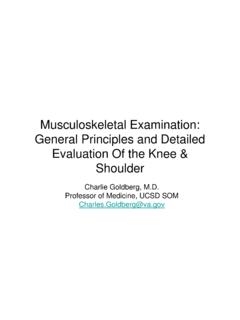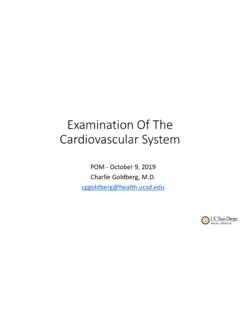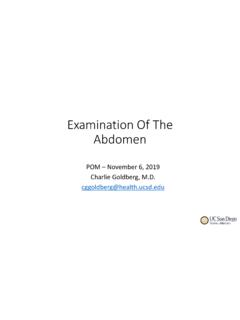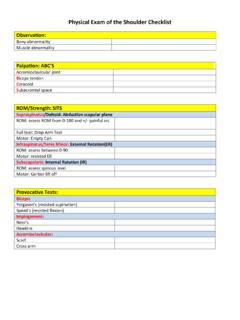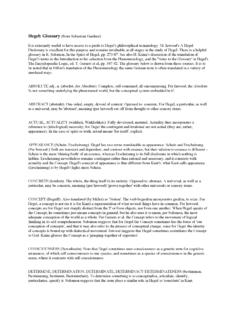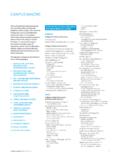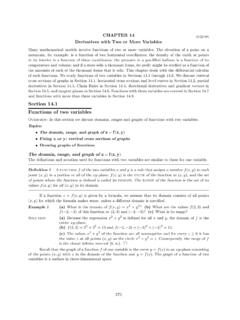Transcription of Neurologic Exam - University of California, San Diego
1 Neurologic ExamCharlie Goldberg, of Medicine, UCSD SOMPOM February 19, of The Neuro Exam Cranial Nerves Motor bulk, tone, strength Coordination fine movements, balance Sensation pain, touch, position sense, vibration Reflexes GaitCN 1-Olfactory Check air movement thru eanostril separately push gently on outside of nostril, occluding it. Then ask patient to inhale/exhale thru other, assuring it s unobstructed. Screen for problems w/sense using coffee (or other substance w/strong odor) Ask patient to close eyes & identify the odor as you bring the substance close to the nostrils Odor normally detectable @ distance of ~10cmCN 1-Olfactory: Sense of Smell Check air movementthru eanostril separately. Smellnot usually assessed (unless sx) use coffee grounds or other w/distinctive odor ( mint, wintergreen, etc)-check eanostril independently -detect odor when presented @ 10cm.
2 Coffee!Cranial Nerve 2 (Optic):Functional Assessment Acuity Using hand held card (held @ 14 inches) or Snellen wall chart, assess each eye separately. Allow patient to wear glasses. Direct patient to read aloud line w/smallest lettering that they re able to see. Hand Held Acuity CardFunctional Assessment Acuity (cont) 20/20 =s patient can read at 20` with same accuracy as person with normal vision. 20/400 =s patient can read @ 20` what normal person can read from 400` ( very poor acuity). If patient can t identify all items correctly, number missed is listed after a - sign ( 20/80 -2, for 2 missed on 20/80 line).Snellen Chart For Acuity TestingCranial Nerve 2 (Optic): Functional Assessment -Visual FieldsLesion #1 Lesion #3 Images from: Wash Univ. School of Medicine, Dept Neuroscience Interactive case w/demo of visual field losses: 2 -Checking Visual Fields By Confrontation Face patient, roughly 1-2 ftapart, noses @ same level.
3 Close your R eye, while patient closes their L. Keep other eyes open & look directly @ one another. Move your L arm out & away, keeping it ~ equidistant from the 2 of you. A raised index finger should be just outside your field of 2 -Checking Visual Fields By Confrontation (cont) Wiggle finger & bring it in towards your noses. You should both be able to detect it @ same time. Repeat, moving finger in from each direction. Use other hand to check medial field ( starting in front of the closed eye). Then repeat for other eye. Pupillary Response (CNs 2 and 3) Pupils modulate amount of light entering eye (like shutter on camera) Dark conditions dilate; Bright constrict Pupils respond symmetrically to input from either eye Direct response =s constriction in response to direct light Consensual response =s constriction in response to light shined in opposite eye Light impulses travel away (sensory afferents) from pupil via CN 2 Impulses that cause ciliary muscles to constrict are carried via parasympathetic (travel alongside CN3) Impulses that cause ciliary muscles to dilate carried viasympathetic chainPupillary Response Testing: Technique Make sure room is dark pupils a little dilated, yet not so dark that cant observe response can use your hand to provide shade over eyes Shine light in R eye.
4 R pupil constricts Again shine light in R eye, but this time watch L pupil (should also constrict) Shine light in L eye: L pupil constricts Again shine light in L eye, but this time watch R pupil (should also constrict) Describing Pupillary Response Normal recorded as: PERRLA(Pupils Equal, Round, Reactive to Light and Accommodation) w/accommodation = to constriction occurring when eyes follow finger brought in towards them, directly in middle ( when looking cross eyed ). Abnormal appearance of one pupil (anisocoria) and/or response to light occurs secondary to: CN 2 impairment (afferents): pupil doesn t respond to light in affected eye Disrupted sympathetics(1st, 2nd, or 3rdorder neurons): affected pupil appears constricted will respond to light, though dilates slowly Disrupted parasympathetics(often accompanies injury to CN3): affected pupil appears dilated, min response to light Meds can affect both pupils: sympathomimetics (cocaine) dilate, narcotics (heroin) 3, 4 & 6:Extra Ocular Movements Eye movement dependent on Cranial Nerves 3, 4, and 6 & muscles they innervate.
5 Allows smooth, coordinated movement in all directions of both eyes simultaneously There s some overlap between actions of muscles/nervesImage Courtesty of Leo D Bores, Occular Anatomy: Nerves (CNs) 3, 4 & 6 Extra Ocular Movements (cont.) CN 6 (Abducens) Lateral rectus muscle moves eye laterally CN 4 (Trochlear) Superior oblique muscle moves eye down (depression) when looking towards nose; also rotates internally. CN 3 (Oculomotor) All other muscles of eye movement also raises eye lid & mediates pupillary & Muscles That Control Extra Occular MovementsCN 6-LRCN 6-LRCN 4-SOSO 4 , LR 6 , All The Rest 3 SRIRMRIOSRIRLR-Lateral RectusMR-Medial RectusSR-Superior RectusIR-Inferior RectusSO-Superior ObliqueIO-Inferior Oblique6 Cardinal DirectionsMovementTechnique For Testing Extra-Ocular Movements To Test: Patient keeps head immobile, following your finger w/their eyes as you trace letter H Eyes should move in all directions, in coordinated, smooth, symmetric fashion.
6 Hold the eyes in lateral gaze for a second to look for nystagmusFunction CN 5 -Trigeminal Sensation: 3 regions of face: Ophthalmic, Maxillary & Mandibular Motor: Temporalis & Masseter muscles Function CN 5 Trigeminal (cont.)Ophthalmic(V1)Maxillary (V2)Mandibular (V3)Temporalis (clench teeth)Masseter (move jaw side-side)SensoryMotor* Corneal Reflex: Blink when cornea touched -Sensory CN 5, Motor CN 7 Temporalis & Masseter Muscles Courtesy Oregon Health Sciences University : ~bobh/Testing CN 5 -Trigeminal Sensory: Ask ptto close eyes Touch eaof 3 areas (ophthalmic, maxillary, & mandibular) lightly, noting whether patient detects stimulus. Motor: Palpate temporalis & mandibular areas as patient clenches & grinds teeth Corneal Reflex: Tease out bit of cotton from q-tip-Sensory CN 5, Motor CN 7 Blink when touch cornea w/cotton wispCN 7 (Facial) Exam Observe facial symmetry Wrinkle Forehead Keep eyes closed against resistance Smile, puff out cheeks and symmetric!
7 The Ear Functional Anatomy and TestingCN 8 (Acoustic) Crude hearing tests: rub fingers next to either ear; whisper & ask ptrepeat words Ifhearing loss, determine: Conductive(external canal up to but not including cochlea & auditory branch CN 8) v Sensorineural(cochlea & auditory branch CN 8)Cunningham L, et al. NEJM 2017;377 8 -Defining Cause of Hearing Loss -Weber Test 512 Hz tuning fork -this (& not 128Hz) is well w/in range normal hearing & used for testing Get turning fork vibrate striking ends against heel of hand orSqueeze tips between thumb & 1stfinger Place vibrating fork mid line skull Sound should be heard equally, R and L bone conducts to both 8 -Weber Test (cont) If conductivehearing loss ( obstructing wax in canal on L) louder on L as less competing noise.
8 If sensorineuralon L louderon R Finger in ear mimics conductive lossCN 8 -Defining Cause of Hearing Loss -Rinne Test Place vibrating 512 hztuning fork on mastoid bone (behind ear). Patient states when can t hear sound. Place tines of fork next to ear should hear it again as air conducts better then bone. If BC better then AC, suggests conductivehearing loss. If sensorineuralloss, then AC still > BC Note: Weber & Rinne difficult to perform in loud areas due to competing noise repeat @ home in quiet room!Oropharynx: Anatomy & Function CNs 9 (Glossopharyngeal), 10 (Vagus), 12 (Hypoglossal) CN 9 &10 are tested together Check to see uvula is midline Stick out tongue, say Ahh use tongue depressor if can t see Normal response: palate/uvula rise Gag Reflex provoked with tongue blade or q tip -CN 9 (afferent limb), 10 (efferent limb) test this bilaterally CN 12 Hypoglossal Stick out tongue is it midline?
9 Have patient push tongue into their cheek while you resist from the outsideNeck Movement (CN 11 Spinal Accessory) Turn headto Linto R hand function of R Sternocleidomastoid(SCM) Turn headto Rinto L hand (L SCM) Shrug shouldersinto your handsAm J Med 2018; 131 (11): 1294 Core Anatomic And Functional Aspects of the Nervous SystemBrainSpinal CordPeripheralNervous SystemMotor/StrengthAnatomy and Physiology Impulse starts brain Axon (upper motor neuron) crosses opposite side @ brain stem Travels down spinal cord specific level Corticospinal (Pyramidal) Tracts Synapses w/2ndneuron (lower motor neuron) Leaves cord & travel to target muscle Muscle movesWashington University (St Louis) School of Medicine -Dept Neuroanatomy Observation/Bulk and Palpation Make sure to fully expose the muscle that you re examining Note Bulk (amount of muscle mass): accounting for size patient, activity level, age if decreased, ?
10 Symmetric Palpation: feel the major muscle groups provides insight about bulk, also ? any Inflammation, painL calf hypertrophy and R calf atrophyL hand muscle wasting from de-nervationMuscle Tone; Observe For Tremor Tone move major joints (wrists, elbows, shoulders, hips, knees, feet) range of motion Normal fluid Increased w/UMN lesion (spasticity) Decreased (flacid) w/LMN lesion Obvious tremor, unintended movements, fasciculations: Loss of muscle innervation (rare!) Video of fasciculations: Scoring SystemQuantify with 0 5 Medical Research Council Scale (quasi-objective) 0/5 No movement 1/5 Barest flicker movement not enough to move structure to which attached. 2/5 Voluntary movement not sufficient to overcome force of patient able to slide hand across table -but not lift it from surface.
